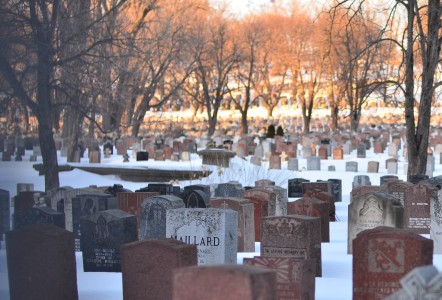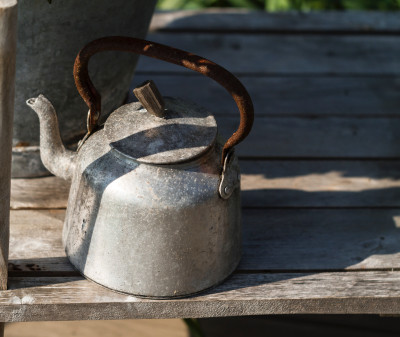While attending college in the Interior of Alaska, at the University of Alaska Fairbanks, I was pursuing a bachelor’s degree in Yup’ik—a Central Alaska Native language—on Halloween of my second year, my professor deemed it appropriate to tell us Alaska Native ghost stories. Hearing these stories in Yup’ik gave unique perspective on the particular experience of growing up in such a harsh environment, his soothing rhythm and melodious speech gave it all an otherworldly feeling. It’s important to keep in mind that while this story is told as a folktale, but all folktales begin as oral stories and all of them have honest beginnings.
The Ghost’s Tea Kettle
There once was a Yup’ik man and a white man who were traveling from one city to another, during one cold January, by dogsled. The two men came upon an abandoned fishcamp alongside the river, and wishing to avoid the harsh cold of the evening, they made camp in one of the houses for the night. They had forgotten to bring a teakettle, but longed for hot tea to provide relief from the chill of the night—the white man recalled having passed a graveyard near the fishcamp, in which there were several teakettles sitting beside some grave markers. Upon hearing the idea, the Yup’ik man told the white man that it was dangerous to take something out of the graveyard, but this advice fell upon deaf ears.
Once the white man had gotten back from retrieving a kettle from the graveyard, he began to boil snow for their tea, but the Yup’ik man refused to drink any. The two companions began to ready themselves for bed when they heard a snapping sound, the house began to shake, and fog began to drift in through every crack in the house. The white man panicked, he didn’t know what was happening, but the Yup’ik man explained to him that a ghost was trying to get into the house.
Suddenly, the door burst open violently, the ghost seeped into the house like a dense white mist, and the door slammed with a bang behind it. The white man screamed and attempted to run in fear, but his escape route had been sealed off by the ghost and he was trapped. The Yup’ik man approached the ghost without fear and put his hand on the ghost’s head—the ghost was so cold, his hand went numb, but he refused to remove it, knowing what he had to do. He gently applied pressure on the ghost’s head and the ghost began to sink slowly into the ground, but soon he grew anxious and tried to push the ghost down faster, this didn’t work to the Yup’ik man’s benefit and the ghost started to come back up.
The Yup’ik man steadied himself, took a breath, slowed down and pushed down once more with a steady and firm hand, until the ghost slowly disappeared into the ground entirely. Unable to stay in the house any longer, the two men packed up all of their belongings, the Yup’ik man told the white man to return the tea kettle to the grave from which it had been taken. They believed that returning the kettle that it would give them freedom from the ghost, but it continued to follow them as a glowing red orb—the Yup’ik man stopped and made markings in the snow, these prevented the ghost from following them, but ended with them becoming incredibly sick. Once they got to the next village, the Yup’ik man had them roll in garbage to throw the ghost off of their scent and then according to traditional practice when dealing with ghosts, they both urinated around their house to keep the ghost away. Eventually they recovered from their illness and left them with the experience that would help teach others to not take what belonged to the dead.

Georgia-based author and artist, Mary has been a horror aficionado since the mid-2000s. Originally a hobby artist and writer, she found her niche in the horror industry in late 2019 and hasn’t looked back since. Mary’s evolution into a horror expert allowed her to express herself truly for the first time in her life. Now, she prides herself on indulging in the stuff of nightmares.
Mary also moonlights as a content creator across multiple social media platforms—breaking down horror tropes on YouTube, as well as playing horror games and broadcasting live digital art sessions on Twitch.


